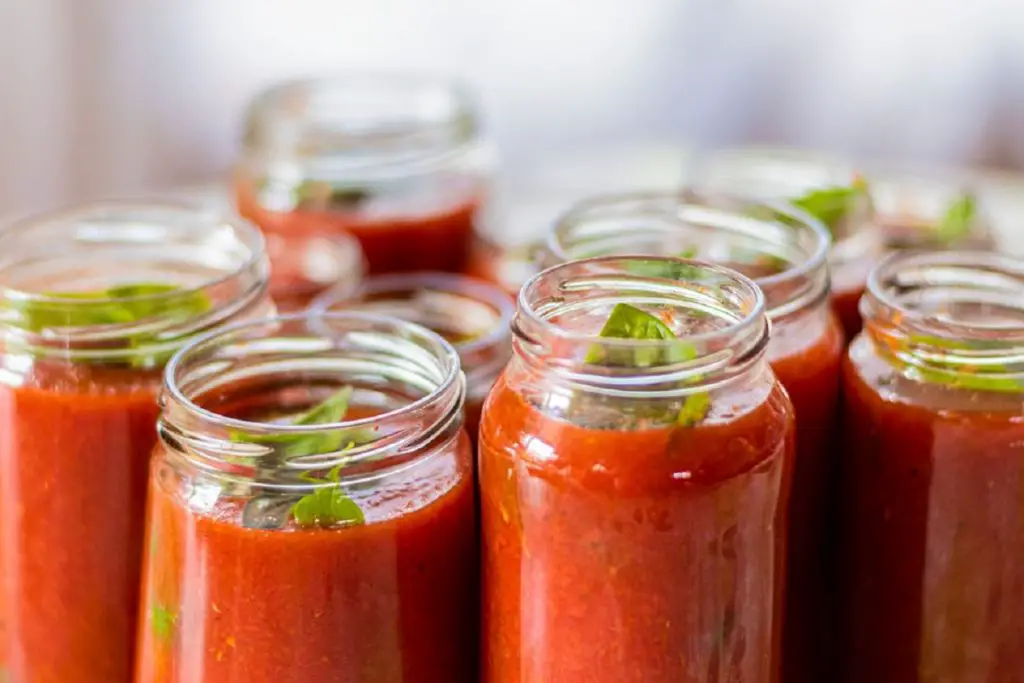Tomato juice is such a versatile ingredient. From pizza and pasta, over delicious soups to scrumptious cocktails, the uses of tomato juice are infinite. Somehow, we always have some laying around the house, except when we actually need it! Having a stash of tomato juice in the freezer solves this problem. Moreover, making juice and freezing it is probably the best way to preserve tomatoes (see also How To Freeze Tomato Puree). In this guide, we’ll go over everything you need to know in order to freeze tomato juice (see also How To Freeze Fruit Juice).

How To Freeze Tomato Juice
Freezing tomato juice (see also Can You Freeze Tomato Paste) is as easy as it can be. Pretty much everything you need is a freezer-safe container you can store the juice in. Other than that, you just need to pour the tomato juice in, close the container, label, and freeze.
What Should I Freeze Tomato Juice In?
When it comes to freezing tomato juice (see also Can You Freeze Tomato Soup), you have lots of options when it comes to containers you can use. However, taking the time to choose the right one can make your life easier later.
If you want to freeze whole, unopened packs of tomato juice to extend its shelf life, you can generally do this with plastic and cardboard containers. Cans and glass bottles or jars are not freezer-safe. The contents can still be frozen but you’ll need to transfer them to a freezer-safe container.
Freezer Containers
When it comes to freezer-safe containers, you can use almost anything to store tomato juice. Hard-sided freezer containers work well. If you have a lot of tomato juice, consider dividing it up into smaller portions. This way, you can always thaw as much tomato juice as you need. There are also plastic jars and cups that are freezer-safe and can work perfectly for storing tomato juice.
Freezer Bags
Freezing tomato juice in freezer bags might sound awkward at first, but it’s actually a great way to store it, especially if you don’t have appropriate containers lying around. The trick is not to try to pour the juice into a free-standing freeze bag. Rather, find a medium bowl inside which you can spread out the bag. Pouring the juice in this way will be easy. When you are done, try to squeeze out as much of the air from the remaining space as possible and close the bag. Lay the freezer bag on the side and freeze. When freezing liquids, it’s a good idea to label your bags before using them. Bags with liquid inside will be difficult to handle. When you place the juiced-filled in the freezer, do not stack them while in liquid form. Once frozen, you can stack them to save space.
Ice Cube Trays
Using ice cube trays to freeze tomato juice is a trick we love. It’s as simple as it sounds, freeze the juice into ice-cubes. However, you do not have to keep it inside the ice cube trays. That would certainly be annoying! Rather, transfer to frozen cubes inside a freezer-bag. Squeezing the air out, or even using a vacuum sealer will help keep the cubes tasting fresh for longer. When you need tomato juice next time, you can simply take out as many cubes as you need. There is no need to worry about portioning in advance.
Tips For Freezing Homemade Tomato Juice

So far we’ve talked about freezing tomato juice in general. But, if you are freezing juice you made at home yourself, there is one tip that can help. Before freezing your tomato juice (see also Freezing Tomatoes), strain it through a fine sieve. This is especially true if your juice still has some piece of tomato inside. While I do prefer a ‘chunkier’ texture in fresh tomato juice, straining it will improve the texture after thawing.
Thawing Tomato Juice
The most low-effort way to defrost pretty much anything is by transferring it into the fridge. No matter how you freeze your tomato juice, this will work. However, if you’ve frozen the tomato juice inside a big container, it might take quite a bit of time to do that completely. It’s best to let it thaw overnight.
However, not all of us think that much in advance, and sometimes we need tomato juice fast. Defrosting in the microwave is always an option if you have one. Simply use the defrost function for a couple of minutes at a time until the juice is completely thawed. Make sure that the container you used for freezing is microwave-safe too!
Finally, if you are using the tomato juice for cooking, you might simply want to use it frozen. This works especially well with tomato juice ice cubes. You can add them into a pan and let thow on low heat, or put them straight into the dish you are cooking.
